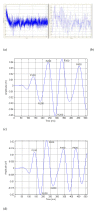A comparative study on long-term evoked auditory and visual potential responses between Schizophrenic patients and normal subjects
- PMID: 21542917
- PMCID: PMC3113739
- DOI: 10.1186/1471-244X-11-74
A comparative study on long-term evoked auditory and visual potential responses between Schizophrenic patients and normal subjects
Abstract
Background: The electrical signals measuring method is recommended to examine the relationship between neuronal activities and measure with the event related potentials (ERPs) during an auditory and a visual oddball paradigm between schizophrenic patients and normal subjects. The aim of this study is to discriminate the activation changes of different stimulations evoked by auditory and visual ERPs between schizophrenic patients and normal subjects.
Methods: Forty-three schizophrenic patients were selected as experimental group patients, and 40 healthy subjects with no medical history of any kind of psychiatric diseases, neurological diseases, or drug abuse, were recruited as a control group. Auditory and visual ERPs were studied with an oddball paradigm. All the data were analyzed by SPSS statistical software version 10.0.
Results: In the comparative study of auditory and visual ERPs between the schizophrenic and healthy patients, P300 amplitude at Fz, Cz, and Pz and N100, N200, and P200 latencies at Fz, Cz, and Pz were shown significantly different. The cognitive processing reflected by the auditory and the visual P300 latency to rare target stimuli was probably an indicator of the cognitive function in schizophrenic patients.
Conclusions: This study shows the methodology of application of auditory and visual oddball paradigm identifies task-relevant sources of activity and allows separation of regions that have different response properties. Our study indicates that there may be slowness of automatic cognitive processing and controlled cognitive processing of visual ERPs compared to auditory ERPs in schizophrenic patients. The activation changes of visual evoked potentials are more regionally specific than auditory evoked potentials.
Figures


Similar articles
-
[Auditory evoked potentials in patients with schizophrenia and affective disorders].Zh Nevrol Psikhiatr Im S S Korsakova. 2002;102(1):56-60. Zh Nevrol Psikhiatr Im S S Korsakova. 2002. PMID: 11842625 Russian.
-
Event-related potentials and genetic risk for schizophrenia.Biol Psychiatry. 2001 Sep 15;50(6):407-17. doi: 10.1016/s0006-3223(01)01072-1. Biol Psychiatry. 2001. PMID: 11566157
-
Auditory event-related potential abnormalities in bipolar disorder and schizophrenia.Int J Psychophysiol. 2004 Jun;53(1):45-55. doi: 10.1016/j.ijpsycho.2004.02.001. Int J Psychophysiol. 2004. PMID: 15172135 Clinical Trial.
-
Auditory and visual P300 reflecting cognitive improvement in patients with schizophrenia with quetiapine: a pilot study.Prog Neuropsychopharmacol Biol Psychiatry. 2010 May 30;34(4):674-80. doi: 10.1016/j.pnpbp.2010.03.011. Epub 2010 Mar 19. Prog Neuropsychopharmacol Biol Psychiatry. 2010. PMID: 20304022
-
Perceptual measurement in schizophrenia: promising electrophysiology and neuroimaging paradigms from CNTRICS.Schizophr Bull. 2012 Jan;38(1):81-91. doi: 10.1093/schbul/sbr106. Epub 2011 Sep 2. Schizophr Bull. 2012. PMID: 21890745 Free PMC article.
Cited by
-
Comparison of auditory and visual oddball fMRI in schizophrenia.Schizophr Res. 2014 Sep;158(1-3):183-8. doi: 10.1016/j.schres.2014.06.019. Epub 2014 Jul 15. Schizophr Res. 2014. PMID: 25037525 Free PMC article.
-
Analysis of EEG entropy during visual evocation of emotion in schizophrenia.Ann Gen Psychiatry. 2017 Sep 25;16:34. doi: 10.1186/s12991-017-0157-z. eCollection 2017. Ann Gen Psychiatry. 2017. PMID: 29021815 Free PMC article.
-
A novel biomarker of amnestic MCI based on dynamic cross-frequency coupling patterns during cognitive brain responses.Front Neurosci. 2015 Oct 20;9:350. doi: 10.3389/fnins.2015.00350. eCollection 2015. Front Neurosci. 2015. PMID: 26539070 Free PMC article.
-
Brain Vital Signs: Expanding From the Auditory to Visual Modality.Front Neurosci. 2019 Jan 18;12:968. doi: 10.3389/fnins.2018.00968. eCollection 2018. Front Neurosci. 2019. PMID: 30713487 Free PMC article.
-
A Correlative Classification Study of Schizophrenic Patients with Results of Clinical Evaluation and Structural Magnetic Resonance Images.Behav Neurol. 2016;2016:7849526. doi: 10.1155/2016/7849526. Epub 2016 Oct 24. Behav Neurol. 2016. PMID: 27843197 Free PMC article.
References
-
- Skrandies W. Visual evoked potential topography: methods and results. Topographic Mapping of Brain Electrical Activity, Butterworth. 1986. pp. 255–260.
-
- Seidman LJ, Pantelis C, Keshavan MS, Faraone SV, Goldstein JM, Horton NJ, Makris N, Falkai P, Caviness VS, Tsuang MT. A review and new report of medial temporal lobe dysfunction as a vulnerability indicator for schizophrenia: a magnetic resonance imaging morphometric family study of the parahippocampal gyrus. Schizophrenia Bulletin. 2003;29(4):803–30. - PubMed
Publication types
MeSH terms
LinkOut - more resources
Full Text Sources
Medical
Miscellaneous

